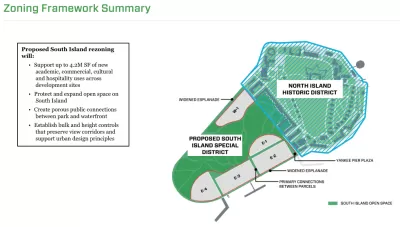Planopedia
Clear, accessible definitions for common urban planning terms.
What Are Zoning Amendments?
Zoning amendments change the existing zoning code by either of two methods: changing the text of the zoning code or changing the zoning map.

Understanding how zoning amendments work, especially compared to similar terms such as zoning variances or special use permits, is critical to understanding the day-to-day practice of planning. Zoning amendments come in one of two forms: zoning text amendments and zoning map amendments. Simply put, a zoning amendment is a change made to a specific section of a zoning code, or area on a zoning map, without requiring a complete rewriting of the zoning code.
Without zoning amendments, zoning codes would be much more static. "A Standard State Zoning Enabling Act," adopted by the United States Department of Commerce in 1922 and revised in 1926 to assist local governments in creating zoning codes, described the need for zoning codes to change as follows: "It is obvious that provision must be made for changing the regulations as conditions change or new conditions arise. Otherwise zoning would be a 'strait-jacket' and a detriment to a community instead of an asset."
A zoning text amendment will rewrite a section of a zoning code that applies to every use permitted in the district, writing the rezoning of land into the zoning code, or by revising specific policy language in the zoning zode. For example, a zoning amendment limiting the size of satellite dishes would apply to all properties. A zoning map amendment changes the zoning district on a particular property or collection of properties. For example, a developer with a proprietor at the edge of the community might apply to change the zoning from an agricultural zone to a single-family residential zone. If approved, the map would be changed to reflect the newly assigned zoning district.
All zoning amendments are usually required to conform with the goals and policies laid out in the comprehensive plan (also known in some jurisdictions as the general plan).
Variances
Zoning amendments can be confused with variances, which similarly allow for a deviation from the original standards set by a zoning code. By comparison, however, variances are intended only for cases involving a unique economic or physical hardship. Variances are designed to allow for change, but only if that change is reflected by the original standards of the zoning ordinance. That's the theory behind variances, anyway. In practice, variances are a source of contentious political controversy.
Similar to zoning amendments, there are two types of variances: a use variance and an area variance. A use variance allows a property to build and maintain a use not explicitly allowed under the zoning district regulations. For example, a use variance could be granted to a business owner who would like to operate an ice cream shop in an area zoned only for residential uses. A use variance would allow the business to operate. An area variance, by comparison, excludes a specific property from physical requirements under the zoning ordinance. For example, an area variance would allow a property owner to build their house with only a 20-foot front setback instead of the required 25-foot setback.
Discretionary Review
Zoning amendments can be initiated by planning department staff, the planning commission, a zoning board of appeals (or similar body), the legislative body (e.g., city council or board of supervisors), or a property owner. The approval process required for a zoning amendment is much more bureaucratic however, and usually requires approval from a legislative body. In most U.S. jurisdictions, planning department staff and planning commissions serve in advisory capacity for zoning amendments—though there are some exceptions to that rule around the country. The approval process for a zoning amendment is thus another version of discretionary approval.
Variances and special permits, on the other hand, are granted by zoning boards of appeals in many jurisdictions without requiring a council action.
Change Is Hard
Both zoning amendments and variances prove the difficulty in allowing exceptions to the rules. While supporters of the flexibility offered by these planning tools argue against the danger of a strict consistency to regulations that don't capture all of the unique strength and weaknesses present in any neighborhood, or on any given parcel, opponents say amendments and variances allow for too much abuse, and diminish the certainty of the process. The field of planning is constantly reevaluating the effects of its tools and how they are deployed, and many planning reforms are designed to allow more by-right development, preventing the need for deviations from the zoning code such as zoning amendments and variances.































